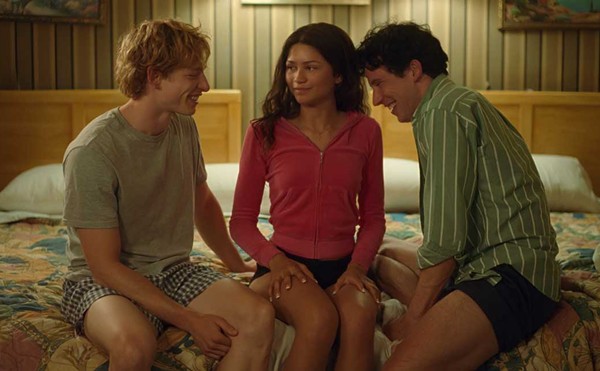George N'Namdi, owner of art galleries in Birmingham and Chicago, recalls an evening years ago when he said to a friend that he hoped to establish an arts journal largely devoted to various strains of African-American painting. The man's response to N'Namdi was, "Why not publish books instead of a journal? Books last longer." N'Namdi tucked the suggestion into a safe corner, allowing it to ripen over the years.
Now he has founded the Belleville Lake Press, whose first publication, Edward Clark: For the Sake of the Search, co-edited by N'Namdi and Barbara Careveri from New York's Metropolitan Museum of Art, has just been released. The monograph of the legendary abstract painter includes meticulous reproductions of images (which is fortunate, since Clark is a master colorist), an essay by critic Anita Feldman, an homage from poet Ted Joans (who with characteristic, succinct brilliance dubs Clark's paintings "erotic reactions") and an interview with Quincy Troupe, detailing the artist's personal and aesthetic developments.
Before becoming a seminal abstract expressionist painter, Clark served in the U.S. Air Force and then took advantage of the GI Bill to study at the Art Institute of Chicago, where he struck up a lifelong friendship with fellow abstract expressionist Joan Mitchell. In the early 1950s he moved to Paris, soaking up European painting influences and American musical ones (the bebop of Charlie Parker and Dizzy Gillespie, among others, raged through the city at that time) and developing his own distinct style of large-scale paintings whose combination of luminosity and rigorous strokes emit a hot and cool sophistication.
Ed Clark: "They (the art establishment) assumed the whole abstract expressionist movement and anything related to it was inhabited only by white males. They thought black painters should paint their own people, like Romare Bearden and Jacob Lawrence did. I mean, the two of them are geniuses and were recognized, but at the same time, an abstract artist like Norman Lewis was ignored, even though he hung out with Rothko, de Kooning and lots of others. ... I remember Algernon Miller said that in the arena of 'high art,' 'painting is the last area of racial superiority.' These days there are a number of outstanding African-American abstractionists, like Al Loving, Sam Gilliam, William T. Williams, Raymond Saunders, Jack Whitten, to name only a few. That makes it hard to understand how you can walk into N.Y.'s four main museums and there still won't be one abstract painting by a black artist on the walls. They'll tell you they represent blacks, but the work will be in the basement."
Edward Clark: For the Sake of the Search, Belleville Lake Press, 1997
Clark's densely layered paint applications mean he must work with his canvases lying on the floor, rather than hanging from a wall or easel, "because of the dripping that would occur with gravity." His tools include his fists, thick brushes and, most often, different sizes of push brooms, which substantially contribute to the physicality of these works. There is something at once airborne and grounded in all of them. Many have clear bands of color across the center, which invite landscape references, though there is an equal, perhaps feminine, sense that the works seem to open up and envelop the viewer.
But perhaps the strongest presence in Clark's paintings is the focus on shapes within and beyond the picture frame. Clark has worked with shaped canvases, and he is widely credited with making the first extended shape painting (continuing the painting out of its rectangular frame with paper and wood) in 1956. "It wasn't called a shape painting then, just something strange and different that began with that painting," Clark said. The untitled work was shown in 1957 at the Brata Gallery on East 10th Street in New York, which Clark helped found upon his return from Paris with such artists as Al Held, George Sugarman and Helen Frankenthaler.
Collectors of Clark's work include an international group of museums, corporations, galleries and individuals, such as the estate of the deceased Reginald Lewis, the first African-American millionaire, and jazz musician Ornette Coleman. (Coleman, as Clark tells it, entered the gallery and right away bought a painting he'd never seen, explaining he had dreamt of it two nights earlier.)
Clark has visited Nigeria, Crete, Brazil and New Mexico, among other locations, to make various series of paintings capturing elements of the distinctive atmospheres he experienced. Now on view at Birmingham's G.R. N'Namdi gallery are examples of two such "landscapes": one based on stays in Sicily, the other based upon a visit to Egypt this summer. Both selections illustrate Clark's interest in using paint to investigate density and light; both offer examples of his highly polished and fluid improvisations, yet there are instructive differences in the two bodies of work.
For the Sicilian scenes, Clark worked pure pigment with his hands. The rounded, soft shapes made with deft rubs and smudges result in floating arrangements of color and form, which radiate a gentle elegance and capture the sultry sensibility he found on that island. His purples (there are a range of them) recall a darkening sky or carafes of wine; his deep blues, a plate piled with squid or vast bodies of water.
In contrast, the Egyptian paintings pulsate with muscular spirit. Some of the thick layers of in-your-face, shimmering acrylic colors and heavy strokes (executed with various-sized push brooms) travel across the canvas in straight and wavy lines. Others form swirls and ellipses which exude an arousing physicality. Clark's colors have multiple references: Certain hues of deep reds and yellows might depict a setting sun or jewels tucked in tombs, whereas fluorescent tones of those colors are more likely to evoke glaring city lights and blinking neon signs. Grainy browns stir up images of river bottoms, pyramids, unpaved roads and nondescript contemporary buildings. Clark's weaving together of ancient and modern elements declares the deep, puzzling vibrancy he found coursing through Egyptian civilization.
Available at Ed Clark's vibrant exhibition with N'Namdi in Birmingham for the next month will be copies of the Belleville Lake Press book, an informative and invaluable text. Hopefully, readers can look forward to more such editions filling gaps in American art education and history.
E-mail comments to [email protected]




